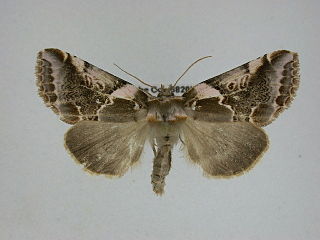
The buff arches is a moth of the family Drepanidae. The species was first described by Johann Siegfried Hufnagel in 1766. It is found throughout Europe and is well distributed in the British Isles except the far north of England and all of Scotland. They live in deciduous and coniferous forests with large populations of their foodplants, but also in gardens and parks.

Colias is a genus of butterflies in the family Pieridae. They are often called clouded yellows in the Palearctic and sulphurs in North America. The closest living relative is the genus Zerene, which is sometimes included in Colias.

The Thyatirinae, or false owlet moths, are a subfamily of the moth family Drepanidae with about 200 species described. Until recently, most classifications treated this group as a separate family called Thyatiridae.

Colias aurorina, the Greek clouded butterfly or dawn clouded yellow, is a butterfly in the family Pieridae. It is found in Central Greece, the Near East and the Caucasus area. It is rare in former Yugoslavia.

Tridrepana is a genus of moths belonging to the subfamily Drepaninae.

Habrosyne scripta, the lettered habrosyne or scribe, is a moth of the family Drepanidae. It was first described by Philip Henry Gosse in 1840. It is found in southern Canada and the northern United States, from Labrador to Vancouver Island, south in the Appalachians, Ozarks and Rocky Mountains to North Carolina and Mississippi and south in the west to Arizona.

Habrosyne is a genus of moths belonging to the family Drepanidae. It was first described by Jacob Hübner in 1816.

Habrosyne armata is a moth in the family Drepanidae first described by Frederic Moore in 1882. It is found in the Khasi Hills of India.
Habrosyne plagiosa is a moth in the family Drepanidae first described by Frederic Moore in 1882. It is found in Sikkim, India.
Habrosyne sanguinea is a moth in the family Drepanidae first described by Frederic Moore in 1882. It is found in Sikkim in India, Tibet in China and Nepal.

Habrosyne fraterna is a moth in the family Drepanidae. It is found in India.
Habrosyne albipuncta is a moth in the family Drepanidae. It is found in Taiwan, China, Vietnam, Thailand and Myanmar.
Habrosyne costalis is a moth in the family Drepanidae. It is found in the Philippines (Luzon).
Habrosyne dentata is a moth in the family Drepanidae. It is found in China.

Habrosyne dieckmanni is a moth in the family Drepanidae. It is found in the Russian Far East, Japan, north-eastern China and Korea.

Habrosyne gloriosa, the glorious habrosyne moth, is a moth in the family Drepanidae. It is found in North America, where it has been recorded from the northern United States, south in the Rocky Mountains to Arizona. In Canada, it is found in Ontario and Quebec.
Habrosyne intermedia is a moth in the family Drepanidae. It is found in the Russian Far East, the Korean Peninsula, Japan, India, Nepal and China.
Habrosyne obscura is a moth in the family Drepanidae. It is found in Indonesia (Java).
Habrosyne sumatrana is a moth in the family Drepanidae. It is found in Indonesia (Sumatra).
Habrosyne violacea is a moth in the family Drepanidae. It is found in the Russian Far East, Korea, China, Myanmar, Vietnam, Nepal and Sikkim, India.










